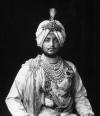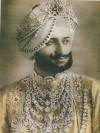|
saLT |
the-south-asian Life & Times January - March 2010 |
|
|||
|
Cover
Feature
Environment 50 years of climate change in Himalaya Face
to Face Nostalgia Future Predictions Tarot Readings Interview Bill Moyers on Fundamentalism
|
|
||||
|
Maharaja: The Splendour of India’s Royal
Courts An exhibition at The Victoria & Albert Museum, London Bhupinder Singh of Patiala; Sir Yadavindra Singh, Maharajah of Patiala, wears a diamond and platinum parade necklace created by Cartier in 1928 for his father Sir Bhupinder Singh.Cartier Archives © CartierThe V&A’s autumn exhibition, Maharaja: The Splendour of India’s Royal Courts, is the first to comprehensively explore the world of the maharajas and their extraordinarily rich culture. It brings together over 250 magnificent objects, many on loan to the UK for the first time from India’s royal collections of the Maharaja Fateh Singh Museum; the Maharaja Ganga Singhji Trust; the Maharana of Mewar Charitable Foundation; the Mehrangarh Museum Trust; Jyotiraditya M Scindia of Gwalior; and Princess Devaki Singh of Kapurthala. Among the exhibits are three thrones, a silver gilt howdah, gem-encrusted weapons, court paintings, photographs, a Rolls Royce, Indian turban jewels and jewellery commissioned from Cartier and Van Cleef & Arpels in the 20th century. The exhibition covers the period from the 18th century when the great era of the maharajas began to the end of British rule in 1947. It shows the changing role of the maharajas in an historical and social context and looks at how their patronage of the arts both in India and Europe resulted in splendid and beautiful commissions designed to enhance royal status and identity. Many of the objects have never before been seen in the UK. These include important loans from royal collections in India: Udaipur and Jodhpur have loaned a large number of significant paintings and objects and wonderful costumes and portraits are being borrowed from Bikaner, Gwalior, Kapurthala and Baroda. On public display for the first are two 1930s portraits of the Maharaja of Indore, by Bernard Boutet de Monvel, and the Patiala Necklace, part of the largest single commission that Cartier has ever executed. Completed in 1928 and restored in 2002, this piece of ceremonial jewellery originally contained 2,930 diamonds and weighed almost a thousand carats. The displays explore the ideas of kingship in India and the role of the maharaja as religious leader, military and political ruler and artistic patron. Symbols of kingship include a gaddi (throne) from Udaipur, elaborate turban jewels, ceremonial swords and a gold ankus (elephant goad) set with diamonds. A palanquin from Jodhpur used to carry the Maharaja’s wife provides a rare glimpse into the lives of ladies at the royal court. The interior of the palanquin contains original framed prints and cushions. Also on display is the golden throne of Maharaja Ranjit Singh, who united the warring factions of the Punjab into a powerful Sikh state, as well as weapons and armour owned by Tipu Sultan of Mysore and the Maratha ruler Yeshwant Rao Holkar of Indore. The 19th century also witnessed the rapid expansion of the territorial interests of the English East India Company, which led to a new hybrid Anglo-Indian style seen in objects such as a Spode dinner service and an Egyptian-revival style chair designed for the Nawab of Awadh. The grand imperial durbars of the Raj era are depicted through large-scale paintings and rare archive film footage and a rare canopy of pearls, rubies, emeralds and diamonds made for the Maharaja of Baroda and exhibited at the durbar of 1903. The exhibition shows the increasing European influence on the lives of the royalty - and how they and their wives were portrayed in both Indian and European style through portraits by photographers and artists including Man Ray, Cecil Beaton and Raja Ravi Varma. The maharajas’ patronage of European firms resulted in luxurious commissions. On display are saris designed by leading French couture houses, a costume by Madeleine Vionnet, a diamond and emerald necklace designed by Van Cleef & Arpels, a Rolls Royce and a Louis Vuitton travelling case. The maharajas were also patrons of the emerging European avant-garde. The exhibition includes modernist furniture commissioned in the 1930s by the Maharaja of Indore for his palace and architectural designs for the Umaid Bhawan palace, an Art Deco style residence commissioned by the Maharaja of Jodhpur. According to Mark Jones, Director of the V&A,: " There has never been an exhibition like this before, showing the spectacular treasures of the courts of the maharajas. Many of the objects have left India for the first time to come to the V&A. This exhibition shows that India’s rulers were significant patrons of the arts, in India and the West, and tells the fascinating story of the changing role of the maharaja from the early 18th century to the final days of the Raj."Maharaja: The Splendour of India’s Royal Courts is at the V&A from 10 October 2009 to17 January 2010, after which it will tour to Kunsthalle der Hypo-Kulturstiftung, Munich, Germany from 12 February to 23 May 2010. A version of the exhibition is planned to tour North America from autumn 2010. The exhibition is curated by Anna Jackson, Deputy Keeper of the V&A’s Asian Department, with consultant curator Amin Jaffer, International Director of Asian Art at Christies and research curator Deepika Ahlawat.
|
|||||
|
Copyright © 2000 - 2010 [the-south-asian.com]. Intellectual Property. All rights reserved. |
|||||

